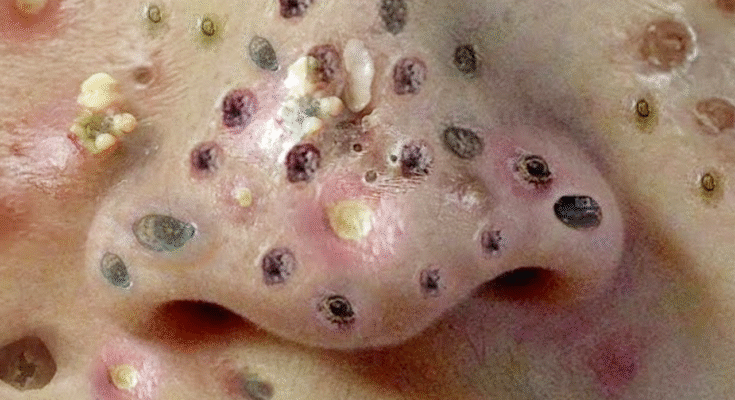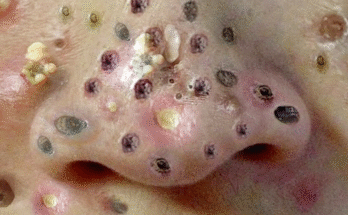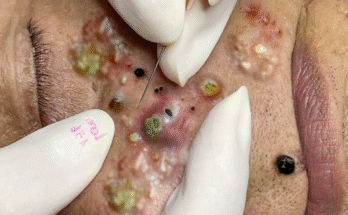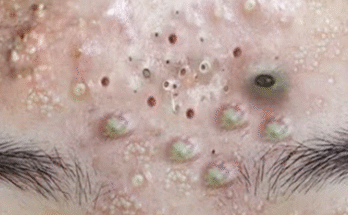Acne isn’t just a skin problem — it’s a whole-body issue influenced by hormones, diet, stress, sleep, and daily habits. Even with the best skincare products, if your lifestyle habits are working against your skin, breakouts can persist.
The truth is, clear skin isn’t achieved overnight or from one miracle serum. It comes from consistency, self-awareness, and a balanced lifestyle that supports your body’s natural ability to heal and regulate itself.
In this comprehensive guide, we’ll explore 10 powerful lifestyle changes that go beyond skincare — evidence-based adjustments that can help reduce acne, regulate oil production, minimize inflammation, and give you the lasting clear, glowing skin you deserve.
1. Balance Your Diet: Feed Your Skin From Within
“Your skin is a mirror of what’s happening inside your body.” This statement isn’t just poetic — it’s biologically accurate. The nutrients you consume, the balance of your blood sugar, and your gut health all play direct roles in acne development.
1.1 Limit High-Glycemic Foods
Refined carbohydrates — white bread, pastries, sugary drinks, and processed snacks — cause rapid spikes in blood sugar and insulin.
High insulin levels increase androgen production (male hormones present in all genders), leading to increased sebum (oil) and clogged pores.
What to avoid:
-
White bread, rice, pasta
-
Candy, soda, desserts
-
Sugary breakfast cereals
What to eat instead:
-
Whole grains (quinoa, brown rice, oats)
-
Leafy greens and non-starchy vegetables
-
Fiber-rich fruits like berries and apples
1.2 Watch Your Dairy Intake
Dairy — especially skim milk — has been linked to acne in several studies. It can stimulate insulin and IGF-1 (insulin-like growth factor), which promotes sebum production and inflammation.
If you suspect dairy contributes to breakouts, try eliminating it for 3–4 weeks and monitor changes.
Better alternatives:
-
Oat milk, almond milk, or soy milk
-
Greek yogurt (in moderation — less sugar, more probiotics)
1.3 Eat More Omega-3 Fatty Acids
Omega-3s (from fish, flaxseed, and walnuts) reduce inflammation and help balance hormones.
Skin-friendly sources:
-
Salmon, sardines, chia seeds, flaxseed oil
-
Supplement: 1000–2000 mg fish oil daily (consult your doctor first)
1.4 Focus on Antioxidant-Rich Foods
Antioxidants fight free radicals that damage skin cells and promote inflammation.
Eat plenty of:
-
Berries (blueberries, blackberries)
-
Green leafy vegetables
-
Nuts, seeds, and green tea
2. Hydrate Like You Mean It
Dehydration doesn’t cause acne directly — but it does make it worse. When your skin is dry, it compensates by producing more oil, which can clog pores. Plus, hydration supports the body’s natural detoxification processes.
2.1 Drink Enough Water
Aim for at least 2–3 liters per day — more if you’re active or live in a dry climate.
2.2 Eat Hydrating Foods
Fruits and vegetables like cucumber, watermelon, and celery provide water and electrolytes that keep skin hydrated from within.
2.3 Limit Dehydrating Drinks
-
Coffee (in moderation is fine)
-
Alcohol (dehydrates and increases inflammation)
-
Sugary sodas (spike insulin and worsen acne)
Pro Tip:
Start your morning with a glass of warm water and lemon — it jumpstarts hydration and digestion.
3. Prioritize Sleep: Your Skin’s Natural Reset Button
Your skin repairs and regenerates while you sleep. When you skimp on rest, cortisol (the stress hormone) rises — increasing oil production and inflammation.
3.1 Aim for 7–9 Hours of Quality Sleep
Deep sleep promotes growth hormone release, which aids in cell repair, collagen production, and overall rejuvenation.
3.2 Create a Bedtime Routine
-
Avoid screens 1 hour before bed — blue light disrupts melatonin.
-
Keep your room cool, dark, and quiet.
-
Practice relaxation — deep breathing, reading, or meditation.
3.3 Change Your Pillowcase Regularly
Pillowcases trap oil, bacteria, and product residue that can clog pores.
Change 2–3 times a week for optimal skin hygiene.
Pro Tip: Sleep on your back to reduce friction and contact acne.
4. Manage Stress: Calm Mind, Clear Skin
Stress doesn’t cause acne by itself, but it’s a major trigger. Chronic stress releases cortisol, which raises blood sugar and increases inflammation — two major acne culprits.
4.1 The Stress-Acne Connection
When stressed, your body:
-
Produces more sebum.
-
Slows skin healing.
-
Disrupts gut bacteria (increasing inflammation).
4.2 How to Manage Stress Effectively
-
Meditation: Even 10 minutes a day reduces cortisol.
-
Exercise: Natural stress reliever that boosts endorphins.
-
Journaling: Helps release emotional tension.
-
Breathwork: Slows the body’s stress response.
Pro Tip:
Practice the 4-7-8 breathing technique — inhale 4 seconds, hold for 7, exhale for 8.
It relaxes your nervous system instantly.
5. Exercise — But Do It Right
Exercise promotes blood circulation, supports detoxification, and balances hormones. However, improper post-workout hygiene can backfire.
5.1 Benefits of Exercise for Skin
-
Boosts blood flow → delivers oxygen and nutrients to skin cells.
-
Reduces stress hormones (cortisol).
-
Balances insulin and improves hormonal health.
5.2 Post-Workout Skincare Hygiene
-
Always cleanse immediately after workouts. Sweat + oil = clogged pores.
-
Avoid tight gym clothes that trap sweat (choose breathable fabrics).
-
Clean gym equipment before use — bacteria on mats or benches can transfer to your skin.
5.3 Choose the Right Exercise
Low to moderate-intensity workouts like yoga, walking, swimming, or cycling improve circulation without overstressing your body.
Pro Tip:
If you struggle with “body acne,” wear moisture-wicking fabrics and shower promptly after exercising.
6. Don’t Touch or Pick Your Face
It’s tempting to pop that pimple — but doing so almost always makes it worse.
6.1 Why You Shouldn’t Pick Acne
-
Transfers bacteria from hands to skin.
-
Pushes infection deeper, causing inflammation and scars.
-
Leads to post-inflammatory hyperpigmentation (dark marks).
6.2 Break the Habit
-
Keep hands busy or away from your face.
-
Use hydrocolloid pimple patches to reduce temptation and protect skin.
-
Keep nails short and clean.
Pro Tip:
If you feel the urge to pick, use a cool compress to reduce swelling or spot treat with benzoyl peroxide or sulfur.
7. Simplify and Consistently Follow a Skincare Routine
Skincare works best when simple, consistent, and targeted. Overloading your skin with harsh actives can lead to irritation and barrier damage.
7.1 Keep It Simple: The 3-Step Foundation
-
Cleanse:
Use a gentle, sulfate-free cleanser with salicylic acid or a mild foaming base. -
Treat:
Apply one or two active ingredients (e.g., niacinamide, benzoyl peroxide, or retinoid). -
Moisturize & Protect:
Use lightweight, non-comedogenic moisturizers and sunscreen daily.
7.2 Avoid Overwashing
Cleansing more than twice a day strips natural oils, causing rebound sebum production.
7.3 Patch Test New Products
Introduce one new product at a time to avoid overwhelming your skin.
Pro Tip:
Consistency beats intensity — give products at least 8–12 weeks before evaluating results.
8. Keep Your Environment Clean
Acne-causing bacteria and oil buildup don’t just come from your skin — they often come from your surroundings.
8.1 Disinfect Your Phone
Your phone collects more bacteria than a toilet seat.
Clean it daily with alcohol wipes or microfiber cloths.
8.2 Change Your Sheets and Towels Regularly
Oil, sweat, and dead skin accumulate on fabric — change sheets weekly, towels every 2–3 days.
8.3 Clean Makeup Brushes
Brushes harbor bacteria and leftover product that can clog pores.
Wash them once a week with gentle soap or a brush cleanser.
9. Support Gut Health
Your gut and your skin are intimately connected through the gut-skin axis. When your gut microbiome is imbalanced (a state called dysbiosis), inflammation increases — often showing up on your skin as acne, eczema, or rosacea.
9.1 Eat More Prebiotic and Probiotic Foods
Probiotics:
-
Yogurt, kefir, sauerkraut, kimchi, miso
Prebiotics (food for probiotics):
-
Bananas, garlic, onions, asparagus, oats
9.2 Avoid Gut Disruptors
-
Excess sugar and alcohol
-
Processed foods
-
Artificial sweeteners
9.3 Consider a Probiotic Supplement
Look for multi-strain probiotics with Lactobacillus and Bifidobacterium species — both linked to reduced inflammation and improved skin clarity.
Pro Tip:
A healthy gut supports balanced hormones, steady blood sugar, and a calmer inflammatory response — all acne-fighting allies.
10. Protect Your Skin from the Sun (and Pollution)
While a little sun may temporarily “dry out” pimples, long-term UV exposure worsens acne marks and slows healing.
10.1 Why Sun Protection Matters
-
UV rays increase inflammation.
-
Sun exposure darkens acne scars (PIH).
-
Pollution adds oxidative stress and blocks pores.
10.2 Daily SPF Is Non-Negotiable
-
Use a broad-spectrum SPF 30–50 every morning.
-
Choose oil-free or mineral-based sunscreens (zinc oxide, titanium dioxide).
-
Reapply every 2–3 hours if you’re outdoors.
10.3 Protect from Pollution
-
Cleanse thoroughly at night to remove pollutants.
-
Use antioxidants (like vitamin C or green tea extract) to neutralize free radicals.
Pro Tip:
SPF is the #1 anti-acne and anti-aging product you can use — it prevents dark spots and scarring.
Bonus Tip: Mind Your Hormones
If acne persists despite lifestyle and skincare changes, it might be hormonally driven — especially if it flares around your cycle, jawline, or chin.
What helps balance hormones:
-
Regular exercise
-
Stable blood sugar (balanced meals)
-
Stress management
-
Sufficient sleep
-
Avoiding endocrine disruptors (like BPA and parabens)
Consult your dermatologist or endocrinologist if you suspect PCOS or hormonal imbalance — hormonal acne often requires medical support (e.g., spironolactone or birth control).
Putting It All Together: Your Clear-Skin Lifestyle Blueprint
| Focus Area | Action Step | Result |
|---|---|---|
| Diet | Reduce sugar, dairy, and processed foods | Less inflammation, stable hormones |
| Hydration | 2–3 liters of water daily | Balanced oil production |
| Sleep | 7–9 hours nightly | Enhanced repair and regeneration |
| Stress | Meditation, exercise, mindfulness | Lower cortisol, calmer skin |
| Exercise | 3–5 times per week | Improved circulation and detox |
| Hygiene | Clean pillowcases, phones, brushes | Fewer breakouts |
| Skincare | Gentle, consistent routine | Strengthened barrier, fewer flare-ups |
| Gut Health | Probiotics and whole foods | Less inflammation |
| Sun Protection | Daily SPF use | Prevents dark spots and scarring |
| Hormone Balance | Holistic lifestyle | Long-term acne prevention |
The Bottom Line: Clear Skin Is a Lifestyle, Not a Quick Fix
Skincare products are powerful — but they can only do so much if your lifestyle is fueling breakouts behind the scenes. Clear skin begins when you treat your body and skin as one interconnected system.
By nourishing yourself with the right foods, resting deeply, managing stress, and maintaining consistent care, you’re doing more than treating acne — you’re creating an environment where your skin can thrive.
Your acne isn’t a reflection of laziness or poor hygiene — it’s a signal. Listen to your skin, adjust your habits, and remember that every small, consistent step adds up.
Because clear skin doesn’t just start with a cleanser.
It starts with you.



